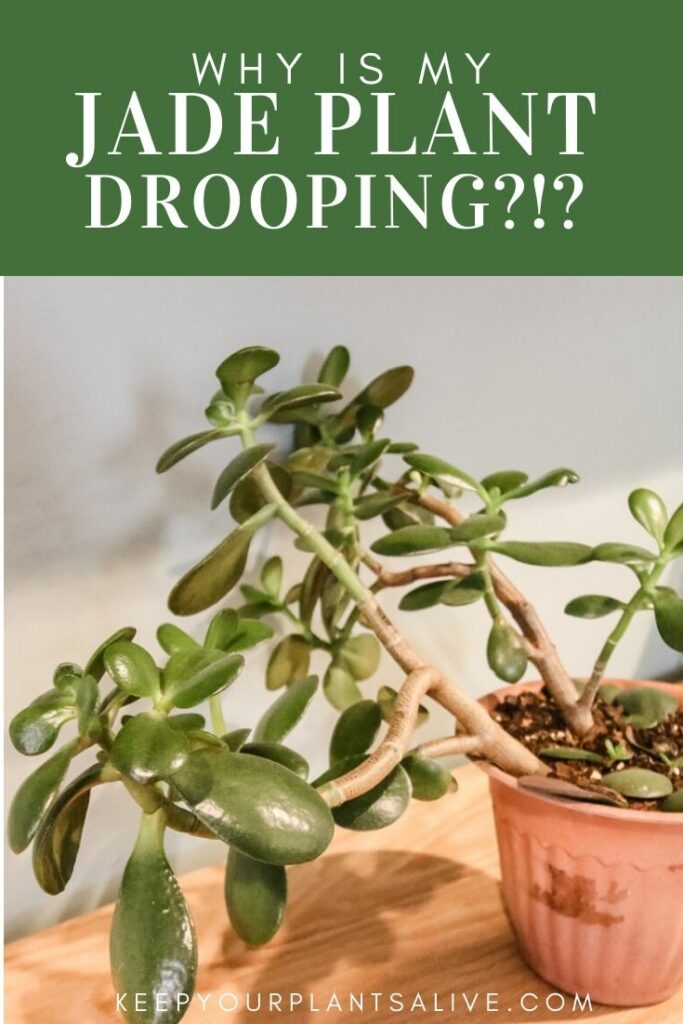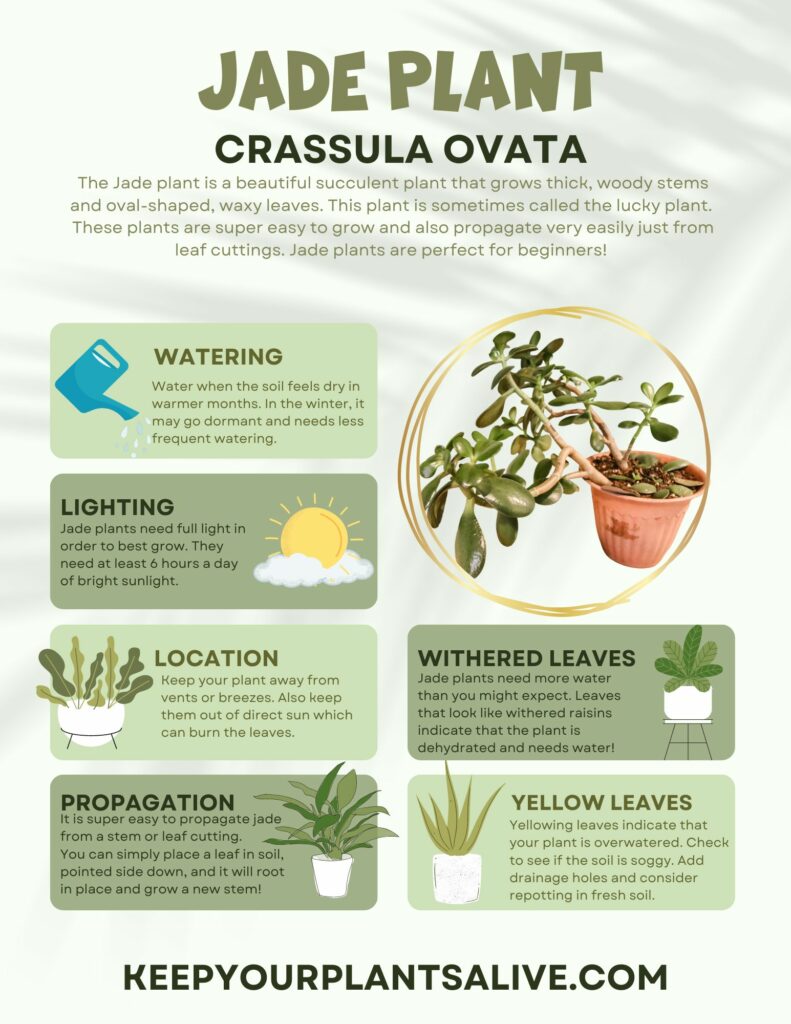Having trouble with jade plant care? Let's talk about why your jade plant's drooping, the top causes, and how to revive a drooping jade plant!
Jade plants are one of the most popular potted houseplants. And for a good reason - they are super easy to care for and do well even when they're a bit neglected.
Plus, their thick waxy leaves give them a really unique look.
So, if your jade plant starts doing poorly, you might feel stumped - or even a little embarrassed.
Today I want to talk about one of the most common jade problems - dropping. Let's dive into what causes a jade plant to droop, and how to revive a droopy jade plant!

Jade Plant Drooping Leaves vs. Drooping Branches: Recognizing the Differences
Drooping plants are often limp and hang downward sadly, rather than pointing out an upward perkily. But, there are different ways that a plant can droop.
I want to talk about the distinction between a jade plant with drooping leaves and a jade plant with droopy branches, because they have different causes and treatments.
Drooping Leaves
Appearance: Leaves appear soft, limp, and wilted, often pointing downwards.
Texture: When touched, drooping leaves may feel thin, soft, and squishy due to the lack of water pressure within the cells.
Causes: Drooping leaves are commonly associated with water-related issues, such as overwatering or underwatering. Overwatering can lead to root rot, causing the leaves to lose turgidity and droop. On the other hand, underwatering causes the plant to lack sufficient water, leading to dehydration and wilting leaves.
Drooping Branches:
Appearance: Entire branches or stems appear weak, bending down or sideways rather than growing upright.
Causes: Drooping branches often result from insufficient light. Jade plants require bright, indirect sunlight to maintain a sturdy, upright growth pattern. Inadequate light causes elongation and weakens the stems, leading to drooping branches.
Texture: Drooping branches may still have firm leaves attached, but the overall structure of the stem is weak, making it bend easily under its weight.
Differences to Look Out For
How can you tell if it is your jade's leaves or branches that are drooping? Here are some things to check!
Leaf Orientation: Pay attention to individual leaves. If the majority of leaves on the plant are drooping, it's likely a leaf-related issue. If entire stems or branches are bending, the problem lies in the plant's overall structure.
Watering Patterns: Consider recent watering habits. If you have been watering excessively, leading to waterlogged soil, drooping leaves are more likely.
Light Exposure: Evaluate the plant's location. If it's placed in a dimly lit area, insufficient light is a probable cause of drooping branches. However, if the plant is in a well-lit spot but still exhibits drooping leaves, water-related issues are more likely.
Overall Plant Structure: Examine the plant as a whole. If only specific parts, such as individual stems or branches, appear weak and droopy, it suggests a branch-related problem. If most leaves throughout the plant are affected, it points toward a leaf-related issue.
By observing these differences and understanding the specific symptoms, you can accurately diagnose whether your jade plant is experiencing drooping leaves or drooping branches. This knowledge is crucial for implementing the appropriate solutions and restoring your jade plant to a healthy, upright condition.
The top causes of drooping jade plants
The most common causes of a drooping jade plant include:
- overwatering
- underwatering
- temperature fluctuations
- nutrient deficiencies
- pest invasion
- weak and leggy growth
Here are more details on each jade plant care issue and solutions for each!
Problem: Overwatering
You need to remember that these plants are succulents and do not need too much water. The most important thing is that your pot have drainage holes to prevent water from pooling in the pot, leading to root rot.
Symptoms: Drooping leaves, yellowing, and mushy stems.
Solution: Allow the soil to dry out completely between waterings. Ensure the pot has drainage holes, and adjust your watering schedule to prevent waterlogged roots.
Here's our complete guide on how to dry wet soil!
Problem: Underwatering
On the other hand, these plants do need to be watered and can suffer if they are under-watered. An underwater jade plant will have the leaves shrivel like raisins. The soil will appear to be super hard and compact, and may need to be fully replaced.
Symptoms: Wrinkled leaves, dry soil, and drooping branches.
Solution: Water the plant thoroughly, ensuring water reaches the root zone. Check the soil regularly, especially in warmer months, and water when the top inch of soil is dry.
Problem: Temperature Extremes
These plants are very sensitive to cold drafts and do not like wild temperature swings.
Symptoms: Drooping leaves or branches due to stress caused by sudden temperature fluctuations.
Solution: Keep the plant away from drafts, open windows, or heating/cooling vents. Maintain a consistent room temperature, avoiding sudden temperature changes.
Problem: Nutrient Deficiencies
Sometimes, these plants just need their vitamins! Fertilizing can be a good option if you haven't done it in a few months.
Symptoms: Yellowing or browning of leaves, weak growth, and drooping branches.
Solution: Fertilize the plant with a balanced succulent fertilizer according to the package instructions. Ensure the plant receives essential nutrients for healthy growth.
Problem: Pests
Of course, you always want to check for a pest infestation which could be bothering your plant.
Symptoms: Drooping leaves, discolored spots, and visible pests like spider mites or aphids.
Solution: Inspect the plant regularly for pests. Treat infestations with natural remedies or insecticidal soap. Isolate the affected plant to prevent the pests from spreading.
Problem: Weak or Leggy Growth
Leggy growth means long spans of branches with no leaves. A long, leggy branch can often get top heavy and droop. I always suggest pruning these off. It's super easy to propagate jade from stem cuttings!
Symptoms: Drooping branches, elongated stems, and sparse foliage.
Solution: Prune the plant selectively to encourage bushier growth. Remove weak or leggy branches to redirect energy into healthier parts of the plant. Provide ample light to prevent stretching.
How to Revive a Drooping Jade Plant
Whatever is going on with your jade plant, there are a few steps to take to help fully assess it and get it healthy again:
- Assess the plant's condition, identifying the specific symptoms such as drooping leaves or branches.
- Adjust your watering routine, ensuring the plant receives adequate moisture without becoming waterlogged.
- Inspect for pests and apply appropriate remedies if infestation is detected.
- Provide optimal light conditions, placing the plant in a location with bright, indirect sunlight.
- Prune the plant strategically to promote a more compact and sturdy growth pattern.
- Be patient; it may take some time for the plant to recover fully. Regular monitoring and consistent care are key to reviving a drooping jade plant.
More about Jade Plants!
- Complete Jade plant care guide
- The best pots for jade plants
- How to propagate a jade plant
- How to properly water jade plants
- Why is my jade plant turning yellow?
- Why is my jade plant dropping leaves?
Printable Jade Plant care guide
Join the (free!) KeepYourPlantsAlive+ community to access this exclusive printable plant care guide! Once you sign up, you can right click & save the JPG care guide. Or keep scrolling for more!

Thanks for reading!


Hey there, I'm Morgan, a houseplant enthusiast from sunny Charleston, South Carolina. Growing up surrounded by my mom's lush orchids and African violets, I discovered the magic of bringing nature indoors. Thanks to the pandemic, I delved deeper into houseplants, discovering their power to uplift moods and transform spaces. I'm here to spill all my secrets, helping you pick the perfect houseplant - and make it happy. Let's keep your plants alive, together! 😊




